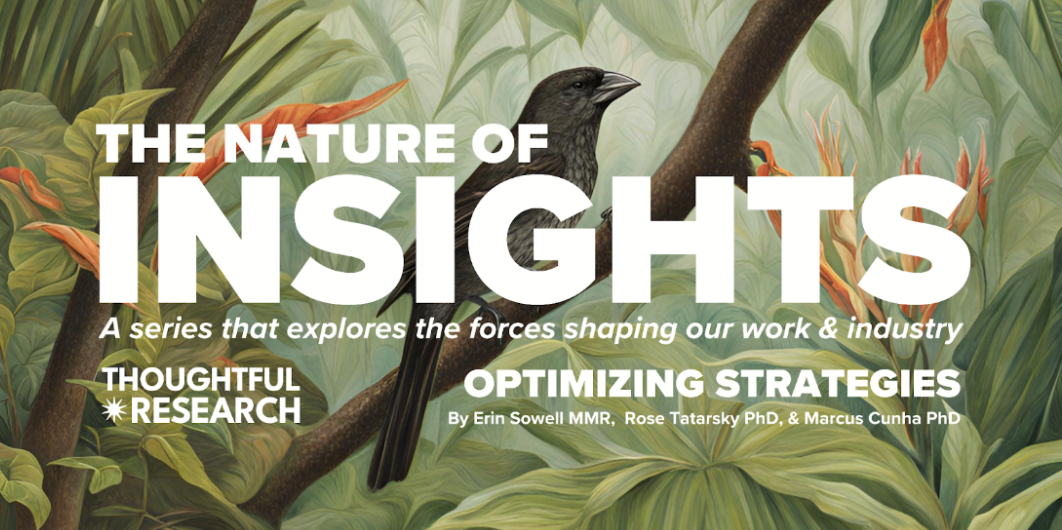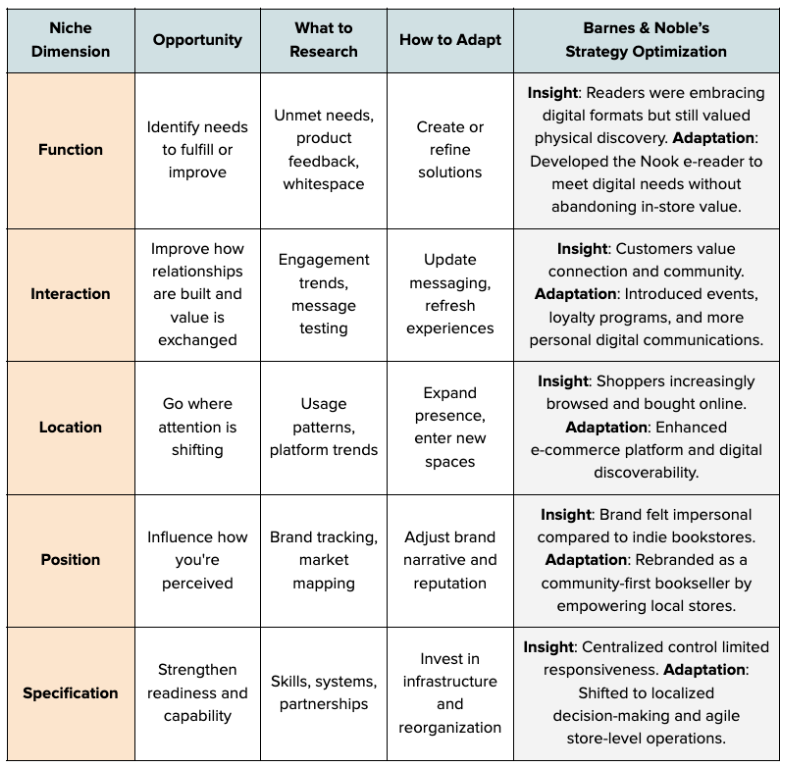The Nature of Insights: Optimizing Strategies
In today’s fast-changing world, adaptation is more than alignment; it is a competitive advantage. This article explores strategic adaptation and the role of insights in facilitating it.

Article series
The Nature of Insights
- The Nature of Insights: Series Introduction
- The Nature of Insights: Understanding Ecosystems
- The Nature of Insights: Optimizing Strategies
Adaptation is the Bridge Between Insight and Impact.
In the first two articles of The Nature of Insights series (Part 1 and Part 2), we explored how the nature of success in business is changing and how ecosystem science offers a powerful framework for navigating complexity. We introduced The TRANSFORM: Framework™, a strategic decision-making approach that guides leaders to success through three steps: Learn, Adapt, and Engineer.
The first step, Learn: Understand Your Ecosystem, encourages leaders to examine their organizations, industries, and markets through an ecosystem lens by identifying the elements, interactions, and dynamics that form their business landscape. But learning is just the beginning. To find success, leaders and brands must take what they learn and turn it into action. This brings us to the second step of the framework: Adapt: Optimize Your Strategy.
Adaptation is not just Alignment. It is a Competitive Advantage.
Adaptation is the process of adjusting to changing conditions or responding to emerging opportunities to survive and grow. In nature, this process unfolds gradually, shaped by external pressures and necessity. Organisms adapt over time by developing traits or behaviors that increase their chances of success. This process is typically reactive and in response to forces outside their control.
Business ecosystems operate similarly. But leaders and brands are not bound by the same constraints. They can adapt quickly and with intention. With the right insight, they can anticipate change, make informed decisions, and shift direction before conditions demand.
Reactive adaptation might keep an organization afloat. Strategic adaptation does more. It allows leaders to reassess priorities, reallocate resources, and reposition themselves to take advantage of changing conditions and emerging opportunities.
The Ecological Niche: A Space of Opportunity
In business, the word "niche" often refers to a small market or specialised product or service. But in ecosystem science, a niche is something broader and more dynamic. It is a space of opportunity where individuals and organizations meet their needs by exchanging value and forming relationships. In other words, niches are spaces where leaders and brands can contribute, connect, and grow.
Every organization, industry, and market is made up of niches, and these spaces are constantly shifting. As conditions change, some niches disappear while others emerge. Niches naturally fluctuate based on the world around them. This is why adaptation matters. To survive and grow, leaders must understand how their ecosystem is changing, identify the spaces where they can succeed, and adapt strategically.
The Five Dimensions that Define Every Niche
While ecological niches are not defined by market size or specialization, they are shaped by opportunity and fit. Each niche represents a distinct space of opportunity, defined by five key dimensions that explain how leaders and brands interact with their organizational, industry, or market ecosystems and what success requires. The five dimensions are:
Function: The need being fulfilled within the ecosystem.
Interaction: How value is exchanged and relationships are formed and maintained, including communication and promotion.
Location: The physical or digital places where opportunities exist.
Position: The status and reputation that a leader or brand holds.
Specification: The resources, capabilities, and conditions required to survive and grow within the niche.
This framework helps clarify what success requires and why some organizations remain resilient while others lose ground. Leaders and brands that understand and adjust their fit within these dimensions succeed. Those that fail to align with the needs of the niche they seek to occupy risk becoming irrelevant.
In the Wild: Bookstores and the Shifting Retail Landscape
Consider U.S. bookstores in the early 2000s. Borders and Barnes & Noble faced the same shifting conditions: digital disruption, the rise of e-commerce, and changing consumer habits. Borders failed to adapt, focusing too much on physical media and outsourcing its online sales to Amazon. Barnes & Noble took a different path, investing in its Nook e-reader, improving in-store experiences, and later emphasizing independent management and community engagement (NPR).
Borders disappeared. The niche that once sustained traditional booksellers no longer existed in its original form. Digital formats, new purchasing behaviors, and evolving reader expectations reshaped the retail ecosystem. What had been a stable space built around physical products, in-store browsing, and centralized control gave way to a new configuration centered on digital access, community interaction, and local responsiveness. The table below outlines how this niche shifted across five dimensions in response to these changing conditions.
 Table 1. The changing bookseller niche. Use this table to assess how niche dynamics may be shifting in your environment. What niche do you or your brand currently occupy? How are the conditions changing? What does this mean for the niche you want to occupy?
Table 1. The changing bookseller niche. Use this table to assess how niche dynamics may be shifting in your environment. What niche do you or your brand currently occupy? How are the conditions changing? What does this mean for the niche you want to occupy?
Strategic Adaptation: From Insight to Action
Adapting is not a one-time event; it is an ongoing process. Once leaders identify shifting conditions or an emerging opportunity, the five niche dimensions can be used as levers to guide that adaptation. Each dimension offers a way to refine alignment, unlock new possibilities, and strengthen resilience.
Insights professionals play a critical role in this process. Our value lies not only in recognizing change and providing information, but also in helping organizations take action. We serve as facilitators of strategic adaptation. Beyond delivering research, we guide conversations, encourage exploration, and support cross-functional collaboration. Through workshops, brainstorming sessions, and strategic planning, we help turn insight into action. This enables leaders to optimize their strategies and improve their fit within a changing ecosystem.
A Roadmap for Facilitating Strategic Adaptation
Strategic adaptation begins by understanding what each niche requires. The five dimensions offer a structured lens to evaluate an organization’s current fit and its future potential. Insights professionals help guide this process by identifying emerging opportunities, understanding the customer, and informing strategy.
The table below illustrates how this approach works in practice. Barnes & Noble’s survival did not happen by chance. It was the result of a deliberate strategy that allowed the brand to move into a changing niche. For each dimension, the table highlights the opportunity to explore, what to research, how to adapt, and how Barnes & Noble applied insight to navigate disruption. With the right insight and action, organizations can strengthen their fit and resilience. Strategic adaptation is not just about reacting to change; it is about using insight to shape your response and chart a forward path.
 Table 2: A Framework for Strategic Adaptation. Use this table to optimize your strategy as conditions change and niches shift. What opportunities are emerging? What should you or your brand be paying attention to? Where is research needed? And how might you adapt your approach to remain relevant, resilient, and ready for what’s next?
Table 2: A Framework for Strategic Adaptation. Use this table to optimize your strategy as conditions change and niches shift. What opportunities are emerging? What should you or your brand be paying attention to? Where is research needed? And how might you adapt your approach to remain relevant, resilient, and ready for what’s next?
Now What: The Expanding Role of Insights Professionals
As the pace of change accelerates, the role of insights professionals continues to grow in importance. Our work is not just about delivering research. It is about helping organizations respond with clarity and purpose. Through research, workshops, and scenario planning, we help leaders make sense of complexity and take thoughtful steps forward. This is ecosystem thinking in practice. It means seeing the business as part of a larger, connected system that is always evolving.
To support strategic adaptation, we must go beyond providing insight. We need to help organizations act on it. That is where The TRANSFORM: Framework™ comes in. Through insight, businesses learn about the ecosystem around them. We can then support adaptation by guiding leaders as they optimize their strategies. This is how we help organizations move from insight to action, and from action to impact.
Join us for the next installment of The Nature of Insights: Securing Success.
In the next article, we will explore the final step of The TRANSFORM: Framework™ — Engineer: Secure Your Success, and how leaders can actively shape their ecosystems. Adaptation is only part of the equation. The most successful organizations go further: they actively shape their ecosystem and make themselves essential within it.
Want to learn more? Watch our TEDx Talk, where we dive into the principles of ecosystem science and introduce The TRANSFORM: Framework™.
Erin Sowell MMR
Researcher, Consultant, & Founder at Thoughtful ResearchErin Sowell is a researcher and consultant who applies ecosystem science to business and marketing. She is the founder of Thoughtful Research, an insights consultancy that helps leaders, brands, and organizations navigate rapidly changing markets and business environments. Prior to Thoughtful Research, Erin was an Associate Manager of Innovation Insights at Georgia Pacific and Research Manager at Kroger's Retail Data Science, Insights, & Media Company, 84.51°. Before entering the Insights Industry, Erin represented the World Corrosion Organization at the United Nations. Erin received her Master of Marketing Research from the Terry College of Business at the University of Georgia and her B.S. in Earth and Environmental Science from Lehigh University.
Rose Tatarsky PhD
Science Communications Consultant at Thoughtful ResearchRose Tatarsky, PhD, is a research scientist specialized in neurobiology and animal behavior. Her work focuses on the neural and genetic mechanisms driving natural behaviors within the context of an animal's environment and evolutionary history. She earned her doctorate from Cornell University in 2022 and currently holds a postdoctoral research position at the Paris-Saclay Institute of Neuroscience. In 2023, Rose joined Thoughtful Research as a Science Communications Consultant, inspired by engaging conversations with Erin about the strategic use of ecosystem science in business & marketing contexts.
Marcus Cunha Jr. PhD
Partner at Thoughtful Research, Marketing Professor at University of GeorgiaMarcus Cunha Jr. is the Robert O Arnold Professor of Marketing at the University of Georgia (UGA) and the Director of the UGA’s Master of Marketing Research (MMR) program. His research focuses on cognition, judgment, and decision-making as applied to understanding issues in pricing and branding. Dr. Cunha’s research has been published in premier research journals such as the Journal of Consumer Research, Journal of Marketing Research, Marketing Science, and Journal of Marketing. He teaches MBA, MMR, and PhD students at UGA. He was awarded the college wide Outstanding Faculty Award for Teaching Excellence and the Hugh O. Nourse outstanding MBA teacher award by the Terry College of Business. Dr. Cunha also teaches the topics of statistical analysis, consumer behavior, behavioral economics, and media effectiveness research to large corporations such as Chick-fil-A, Lowe's, and Assurant, the Georgia Banking Association, and the Advanced School of Marketing Research (American Marketing Association). He has conducted consulting projects for multinational corporations both in the USA and in Brazil and has trained research executives in both countries.
Article series
The Nature of Insights
- The Nature of Insights: Series Introduction
- The Nature of Insights: Understanding Ecosystems
- The Nature of Insights: Optimizing Strategies


